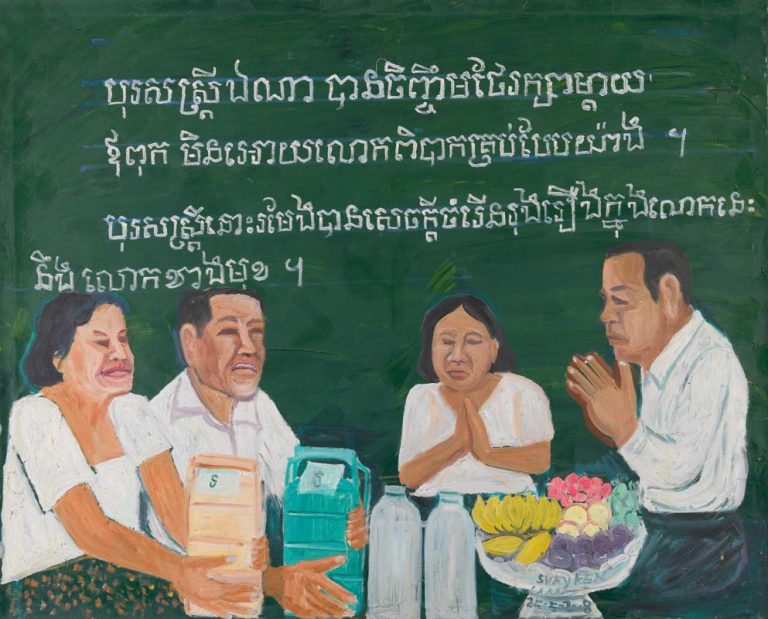We acknowledge the Traditional Owners of the land on which the Queensland Art Gallery | Gallery of Modern Art stands and recognise the creative contribution First Australians make to the art and culture of this country.

Svay Ken / Cambodia 1933–2008 / One who feeds and looks after one’s parents so well that they do not have any problems will be prosperous in this world and the next world (from ‘Sharing knowledge’ series) 2008 / Oil on canvas / 80 x 99.5cm / Purchased 2008. The Queensland Government’s Gallery of Modern Art Acquisitions Fund / © The Estate of Ken Svay
Ken SvayOne who feeds and looks after one’s parents so well that they do not have any problems will be prosperous in this world and the next world (from ‘Sharing knowledge’ series) 2008
Not Currently on Display
Svay Ken’s ‘Sharing knowledge’ series illustrates Buddhist religious and moral statements, offering guidance to the young for living a good and honest life. The works reflect Svay’s early temple education and lifelong ethos, and indicate his concern with the decline of morals and tradition in contemporary Cambodian society. As the artist has said: ‘I didn’t choose to share many lessons on prosperity. I want the young people to know more the causes of self-ruin. Sometimes one’s nature is good, but one commits sins absentmindedly.’1
Svay’s selected statements are painted in a flat, structured format evoking traditional temple murals. The elaborate Khmer script forms a distinctive and central feature of each work, and the images are comprised of group portraits and tableaux. Set against monochromatic backgrounds of dark greens and blacks, and one of yellow, the paintings communicate the artist’s moral advice directly and assertively.
While located in time-honoured religious teachings, they are also grounded in contemporary life; a recurrent theme is the growth of a wealthy urban middle class in Phnom Penh, who often come from farming families and increasingly leave their poorer rural relatives behind. As with all of Svay’s paintings, the apparent simplicity and immediacy of the ‘Sharing knowledge’ series is underpinned by keen observation, a deep understanding of the function of painting in Cambodian society, and a belief in the role of the artist as witness and storyteller.
Endnotes:
1 Svay Ken, ‘Artist’s statement’, in Svay Ken: Sharing Knowledge [exhibition catalogue], Bophana Audiovisual Resource Centre, Phnom Penh, 2008, p.7.
Svay Ken’s powerfully honest and vivid observations of daily life forged a new path for Cambodian contemporary art, in which self-expression and personal history come together. His subjects include still-lifes, portraits, moral allegories and everyday scenes, often drawn from memory and photographs. During his 15-year painting career, Svay was internationally renowned as one of the few Cambodian artists to have openly depicted life under Pol Pot’s Khmer Rouge regime (1975–79).
Svay Ken was born in 1933 into a family of farmers and temple painters in the southern province of Takeo. He was sent to a monastery as a youth, where he studied Buddhist scriptures and philosophy, as well as the Khmer alphabet. As a young man he moved to Phnom Penh, and worked as a porter at the prestigious Hotel Le Royal until he and his family were forced out of the city in 1975 to work as rural labourers.
The family were separated and did not reunite until four years later, following the Khmer Rouge’s defeat by the Vietnamese army, when Svay returned to Phnom Penh and resumed work at the hotel. To continue supporting his family, Svay began painting shortly before his retirement in 1993, at first selling works to hotel guests before gaining local attention. He subsequently began showing regularly in Cambodia and internationally, and became a role model for younger artists.